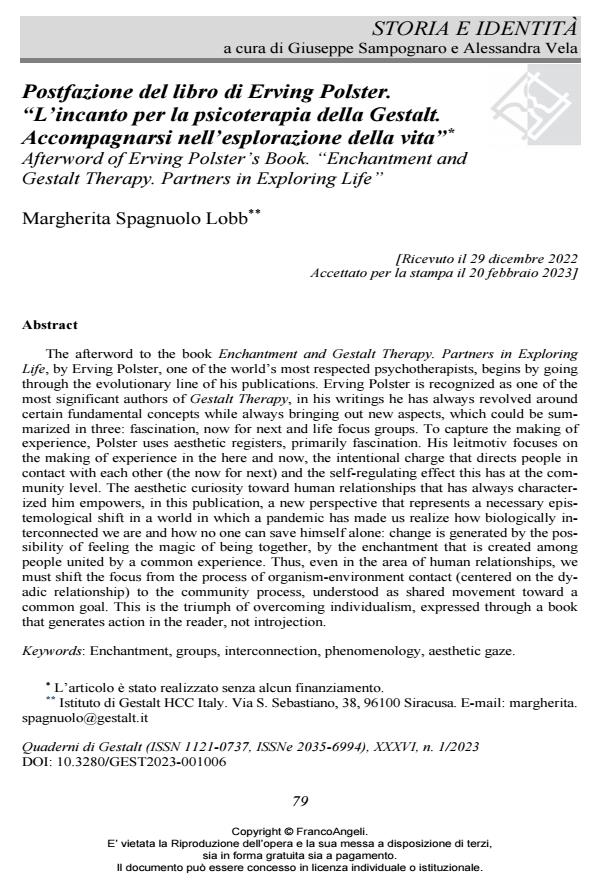Afterword of Erving Polster’s Book. "Enchantment and Gestalt Therapy. Partners in Exploring Life"
Journal title QUADERNI DI GESTALT
Author/s Margherita Spagnuolo Lobb
Publishing Year 2023 Issue 2023/1
Language Italian Pages 11 P. 79-89 File size 188 KB
DOI 10.3280/GEST2023-001006
DOI is like a bar code for intellectual property: to have more infomation
click here
Below, you can see the article first page
If you want to buy this article in PDF format, you can do it, following the instructions to buy download credits

FrancoAngeli is member of Publishers International Linking Association, Inc (PILA), a not-for-profit association which run the CrossRef service enabling links to and from online scholarly content.
The afterword to the book Enchantment and Gestalt Therapy. Partners in Exploring Life, by Erving Polster, one of the world’s most respected psychotherapists, begins by going through the evolutionary line of his publications. Erving Polster is recognized as one of the most significant authors of Gestalt Therapy, in his writings he has always revolved around certain fundamental concepts while always bringing out new aspects, which could be summa-rized in three: fascination, now for next and life focus groups. To capture the making of expe-rience, Polster uses aesthetic registers, primarily fascination. His leitmotiv focuses on the mak-ing of experience in the here and now, the intentional charge that directs people in contact with each other (the now for next) and the self-regulating effect this has at the community level. The aesthetic curiosity toward human relationships that has always characterized him empowers, in this publication, a new perspective that represents a necessary epistemological shift in a world in which a pandemic has made us realize how biologically interconnected we are and how no one can save himself alone: change is generated by the possibility of feeling the magic of being together, by the enchantment that is created among people united by a common experience. Thus, even in the area of human relationships, we must shift the focus from the process of organism-environment contact (centered on the dyadic relationship) to the community process, understood as shared movement toward a common goal. This is the triumph of overcoming individualism, expressed through a book that generates action in the reader, not introjection.
Keywords: Enchantment, groups, interconnection, phenomenology, aesthetic gaze.
Margherita Spagnuolo Lobb, Postfazione del libro di Erving Polster. "L’incanto per la psicoterapia della Gestalt. Accompagnarsi nell’esplorazione della vita" in "QUADERNI DI GESTALT" 1/2023, pp 79-89, DOI: 10.3280/GEST2023-001006